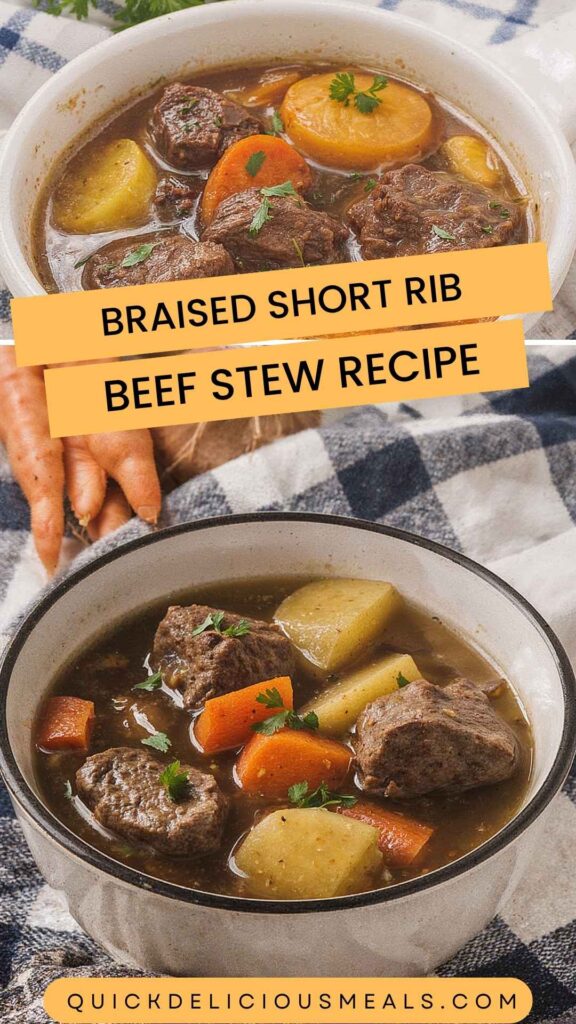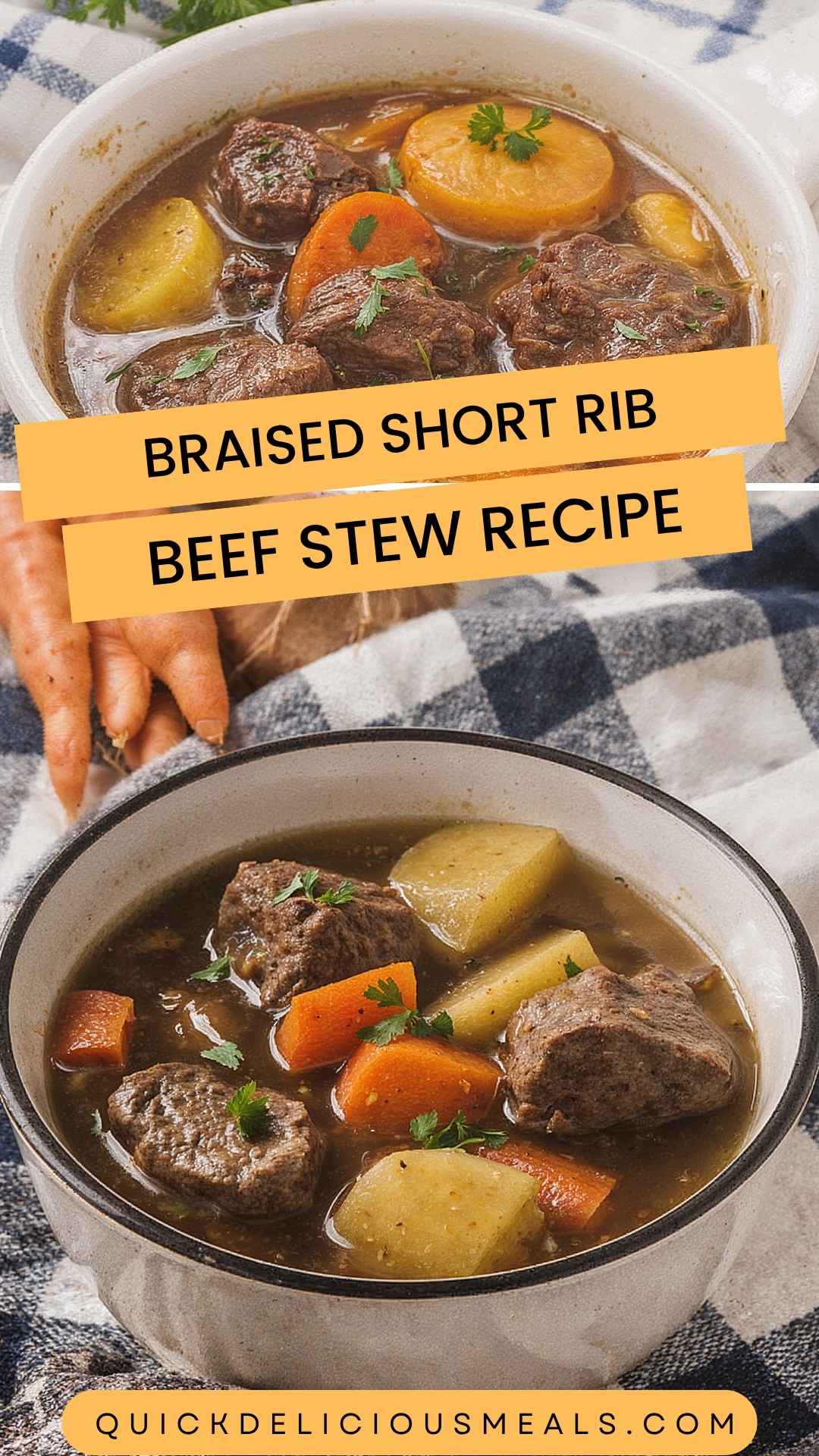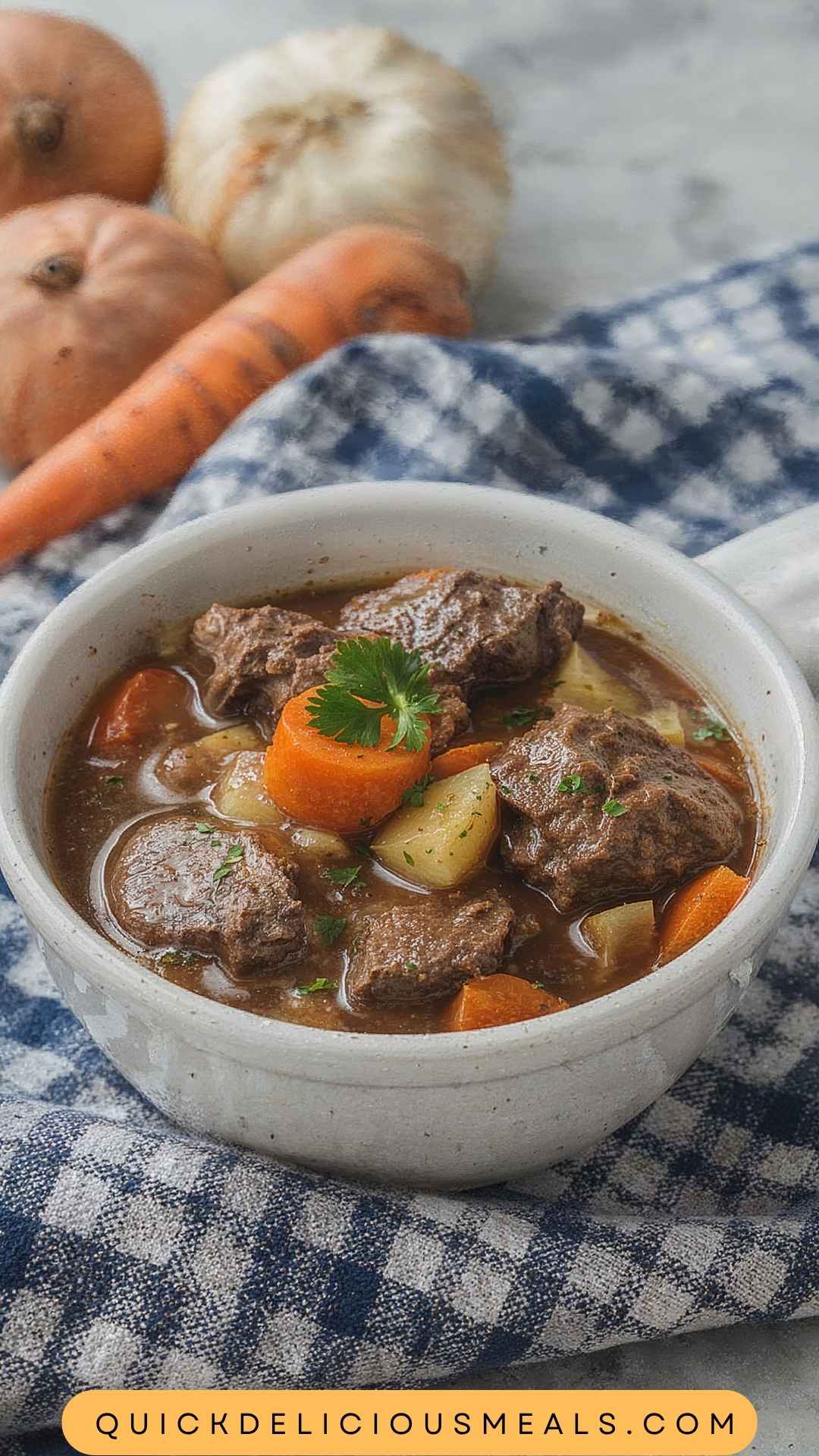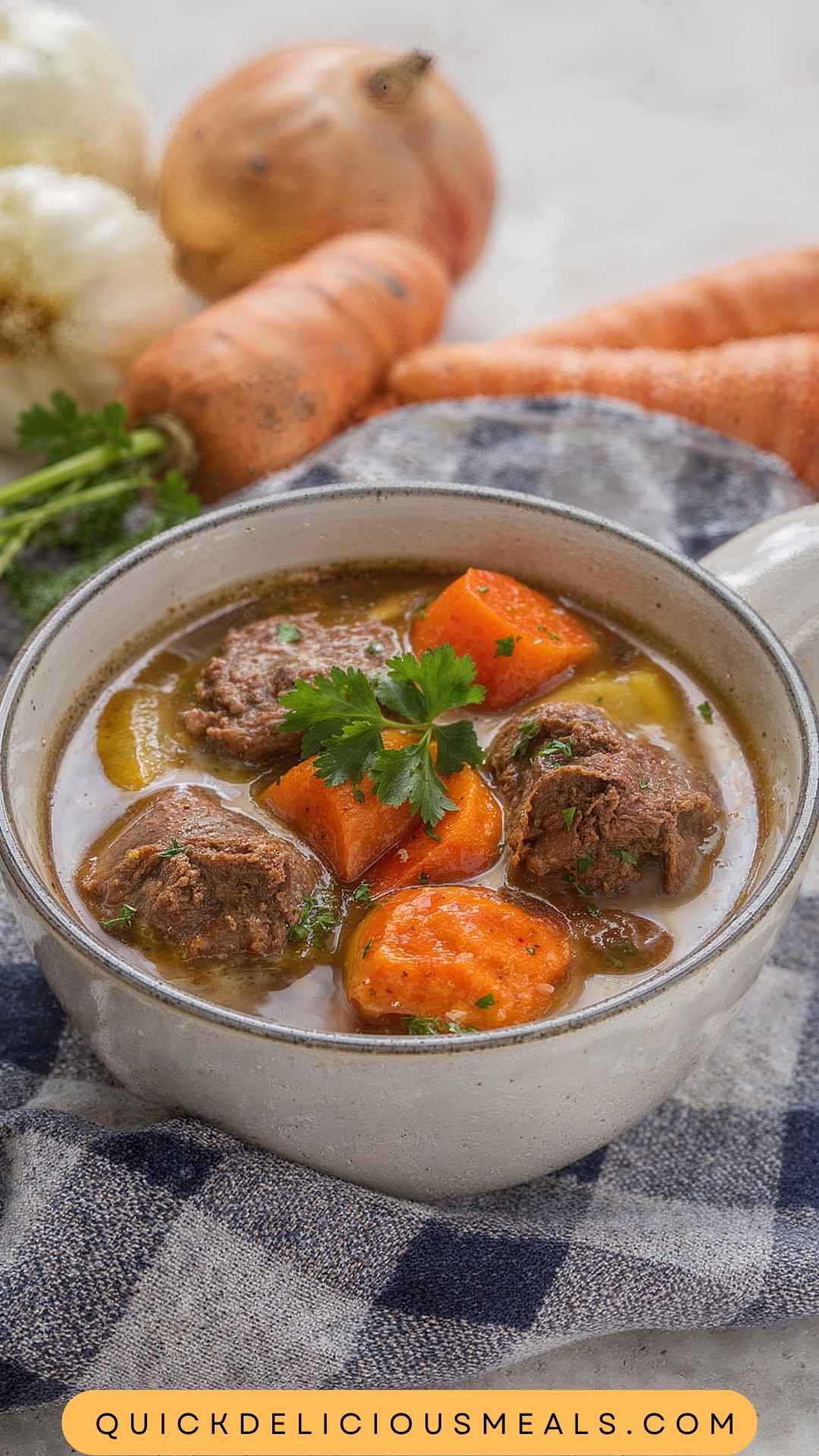Pairing a meal with the right sides can elevate the experience beyond just the food itself. If you're savoring a hearty bowl of braised short rib beef stew, you might want to think about what complements it best.
A thick slice of crusty sourdough bread is perfect for soaking up that rich broth. Alternatively, creamy mashed potatoes can provide a delightful base, balancing the stew's flavors.
Lastly, a simple side salad with a tangy vinaigrette adds freshness and contrast. Now that we’ve set the stage for our feast, let’s dive into the main event.
Why This Recipe Works?
1. Depth of Flavor: The combination of red wine and beef stock gives the stew a full-bodied taste. Slow cooking allows these flavors to deepen and meld together, resulting in a comfort dish you'll crave.
2. Tender & Juicy Short Ribs: Choosing boneless beef short ribs ensures each bite is tender and packed with meatiness. When seared first, the short ribs develop a lovely crust that enhances the taste.
3. Versatile Vegetables: This recipe embraces seasonal vegetables, incorporating carrots, Yukon Gold potatoes, and peas for color, texture, and nutrition. Feel free to switch them up according to what you have on hand—this stew is adaptable.
4. Simple Preparation: With just a few straightforward steps, even novice cooks can craft this dish. Sear, sauté, add, and simmer—it's that easy!
How Does It Taste?
This stew boasts a medley of flavors. The beef is rich and succulent, enriched by the savory broth. The caramelized onions and garlic provide a warm, inviting taste, while the vegetables offer delightful contrast and texture.
When you take a bite, you’ll find the essence of home-cooked comfort. A hint of balsamic vinegar adds a touch of brightness, balancing the stew's depth.
What Sets This Recipe Apart?
Firstly, the emphasis on technique is crucial. While many recipes throw all ingredients into a pot, this one values the process.
Searing the beef and sautéing the vegetables beforehand develops essential flavors. Secondly, the specific choice of ingredients, like the dry red wine and smoked paprika, creates a uniquely complex taste profile.
You won’t find those flavors mingling in just any stew. Lastly, the use of fresh herbs elevates the overall dish. They're not just garnish; they’re integral to the stew's character.
The Ingredients
Let’s gather what you'll need for this flavorful journey.
- 2 lb boneless beef short ribs: Generously seasoned with sea salt and freshly cracked black pepper.
- 3 Tbsp. all-purpose flour: For thickening the stew.
- 1 sweet yellow onion: Thinly sliced for sweetness and depth.
- 3 garlic cloves: Finely chopped for aroma.
- 6 carrots: Peeled and chopped into thick chunks for heartiness.
- 8 Yukon Gold potatoes: Peeled and cut into quarters for texture.
- 2 celery stalks: Roughly chopped to add crunch.
- ½ cup dry red wine: A Cabernet Sauvignon works beautifully here.
- 4 cups rich beef stock: To create a luscious base.
- 10 oz. sweet green peas: Adds a pop of color and sweetness.
- 5 sprigs fresh thyme: Tied with kitchen twine, if desired.
- 1 bay leaf: Adds subtle flavor.
- ½ tsp balsamic vinegar: Balances richness.
- 1 tsp smoked paprika: For a hint of warmth.
- Extra virgin olive oil: For searing and sautéing.
- Salt and black pepper: For adjusting seasoning at the end.
Instructions
Step 1: Sear the Beef
In a large pot or Dutch oven, heat a drizzle of olive oil over medium-high heat. Season the short ribs generously with salt and freshly cracked black pepper.
Once the oil is shimmering, add the ribs. Sear them on all sides until they develop a beautiful brown crust, about 3-4 minutes per side. Remove them from the pot and set aside.
Step 2: Sauté the Aromatics
In the same pot, add a bit more olive oil if needed, then toss in the sliced onions. Sauté for about 5 minutes until they are translucent.
Add the garlic and cook for an additional 1-2 minutes until fragrant. This step is crucial. The foundation of your stew lies here.
Step 3: Add Vegetables
Next, stir in the chopped carrots and celery. Cook for about 5 minutes until they start to soften. This will add another layer to the stew's profile.
Step 4: Deglaze with Wine
Pour in the red wine and use a wooden spoon to scrape up any delicious browned bits stuck to the bottom of the pot. This process is essential for depth of flavor.
Step 5: Build the Stew Base
Now, sprinkle in the flour. Stir well to combine; this will help thicken the stew as it cooks. Gradually add the beef stock while stirring.
Bring the mixture to a simmer, then return the seared short ribs to the pot.
Step 6: Add Herbs and Seasonings
Add the fresh thyme, bay leaf, half a teaspoon of balsamic vinegar, and smoked paprika to the pot. Stir to distribute all flavors evenly.
Step 7: Slow Cook the Stew
Cover the pot and reduce the heat to low; let the stew cook for about 2 to 2.5 hours. This is where the magic happens.
The beef becomes incredibly tender, and the flavors meld beautifully. Stir occasionally to ensure nothing sticks.
Step 8: Time for the Potatoes and Peas
After a couple of hours, add the quartered Yukon Gold potatoes. Cook for another 30-40 minutes until they are fork-tender. Then stir in the sweet green peas during the last 5 minutes of cooking.
Step 9: Final Seasoning
Before serving, taste and adjust the seasoning with salt and pepper. Remove the bay leaf and thyme sprigs.
Notes
Here are five essential tips to elevate your stew game:
Patience is Key: Take your time while searing and simmering. Rushing through these steps can lead to less flavor.
Quality Ingredients Matter: Using high-quality beef and stock will impact the final dish significantly.
Experiment with Veggies: Feel free to add mushrooms or parsnips based on what you have.
Make It Ahead: Stews often taste better the next day as flavors develop.
Thicken or Not?: If you prefer a thicker broth, allow the stew to simmer uncovered for a little longer.
Nutrition Information
This stew packs a nutritious punch. On average, one serving (about a cup) contains:
- Calories: 450
- Protein: 35g
- Carbohydrates: 40g
- Fat: 18g
- Fiber: 4g
- Sodium: 600mg
Of course, these values will vary based on specific ingredients and portions.
How Do You Store This Braised Short Rib Beef Stew Recipe?
Leftover stew can be stored in an airtight container in the refrigerator for up to four days. For longer storage, consider freezing it in portions.
Let the stew cool entirely before transferring it to freezer-safe bags or containers. It can last up to three months in the freezer.
Just remember to label your containers and date them, so you know what’s awaiting you.
Sides for Braised Short Rib Beef Stew Recipe
Having the right side dishes can elevate your meal. Here are three excellent pairings:
Crusty Sourdough Bread: The chewy crust and soft interior make each bite a delight. Use it to mop up that delicious broth, and don’t be shy about slathering some butter on it.
Creamy Mashed Potatoes: While the stew comes with potatoes, creamy mashed potatoes provide a buttery, smooth base that complements the stew beautifully. Whip them up with some garlic and chives for added flavor.
Simple Green Salad: A fresh salad with mixed greens, cherry tomatoes, and a light vinaigrette cuts through the stew's richness. It adds a refreshing contrast and balances the meal perfectly.
What Alternatives Can You Use for the Ingredients if They Are Not Present?
You might discover you’re missing an ingredient. Here are some alternatives:
Beef Substitutes: If you don’t have beef short ribs, you can use chuck roast or brisket. Both will provide similar richness and tenderness when slow-cooked.
Stock Options: If beef stock isn’t available, chicken stock can work in a pinch. Just adjust your seasonings since it has a lighter flavor.
Red Wine Alternatives: For a non-alcoholic option, you can use grape juice with a splash of vinegar to mimic the acidity of wine.
Vegetables Swap: Carrots can be replaced with parsnips or turnips. Similarly, russet potatoes can substitute Yukon Gold if that’s what’s on hand.
Conclusion
There you have it. A hearty braised short rib beef stew that’s sure to fill your kitchen with warmth and your heart with joy.
This recipe connects the simplicity of home cooking with the depth of gourmet dishes. It's a dish that tells a story, whether made for family gatherings or an intimate dinner.
The best part? With a little patience and love, you’re not just following instructions; you’re crafting a meal that resonates with comfort and nostalgia. So roll up your sleeves, gather those ingredients, and let’s get cooking!
You’ll also like the following recipes!





